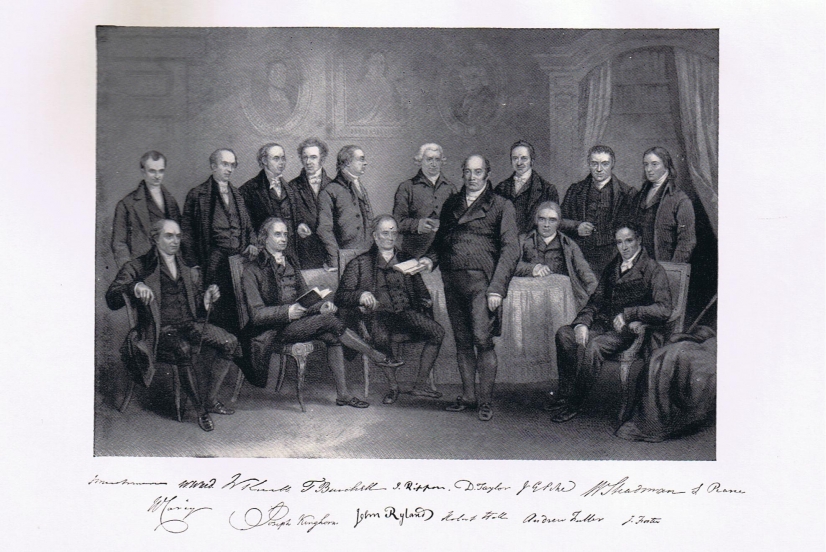I love this painting of a group of Baptists from the English midlands (primarily Northamptonshire, Buckinghamshire and Nottinghamshire).
There are many reasons I love it.
I love it because it reminds me of old photographs that many churches have of their diaconates, mostly all male, and all very worthy, with Bibles and pipes (for tobacco, not bagpipes!) and sat in similar fashion.
I love it because it has echoes of Last Supper paintings, and is a reminder that the story is our story, a continuing story through history.
Most of all, and this is shamelessly self-indulgent, I love it because I can trace connections from myself to some of these men, which is something that intrigues and delights me.
William Carey is sitting, on the left hand end of the front row. Born and brought up in Northamptonshire, he was Baptised in the River Nene, near to what is now the location of the Northampton Railway Station. Nothing that surprising there. The connection comes via the minister who Baptised him, John Ryland (third from the left in the front row) minister of College Lane (later Street) Baptist Church. Among the plants from College Street was a Sunday School in a nearby village called Duston, from which a church emerged, choosing to become Congregational when it gained independence. It was this church, now a URC, where I came to a place of owned Christian faith, at around the age of 15. And it was in this church that I got to know one of my GB leaders, now a friend, whose great grandparents were married in the chapel attended by Mari Jones of Bible Society fame.
In the centre of the back row is a man wearing a white wig. He is, so far as I can ascertain, the odd man out, because he was not a Particluar Baptist but a General Baptist, influenced by the Wesleys, and founder of the New Connexion, at the delightfully named Barton-in-the-Beans in Leicestershire. From there, one of the many plants was in 'Dibley', established in 1749, more than a decade before Carey's birth, and becoming an independent church in 1798. As a former minister of Dibley Baptist Church, I can claim a connection to Dan Taylor.
Other links I may claim are undoubtedly more tenuous, places I've visited/studied such as the John Ryland University Library in Manchester (oodles of Baptist archives in the main John Ryland library), hymns I've sung written by John Rippon, and so on.
When I think of the 'Communion of Saints' or the 'Great Cloud of Witnesses', it is in the light of connections such as these. As someone who is not convinced that heaven is where we reconnect with our nearest and dearest, it is reassuring and comforting to contemplate that the interconnectedness will ensure a shared history, if measured only over centuries rather than years.
